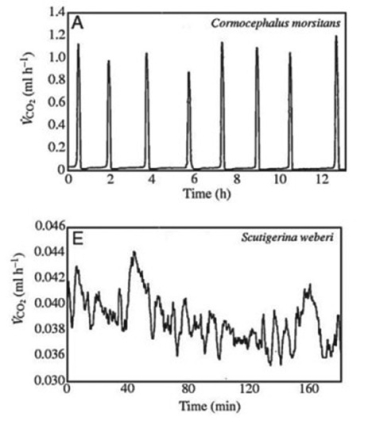Many terrestrial arthropods exchange gases with their environments by using tracheae, tubes that lead from openings (called spiracles) in the animal's exoskeleton or cuticle directly to the animal's tissues. Some arthropods can control whether their spiracles are opened or closed; opening the spiracles allows the carbon dioxide produced in the tissues to travel down the tracheae and be released outside the animal. Klok et al. measured the carbon dioxide emitted over time (represented by VCO₂) by several species of centipedes. The figures present graphs of their results for two species, Cormocephalus morsitans and Scutigerina weberi. (C. J. Klok, R. D. Mercer, and S. L. Chown. 2002. Discontinuous gas-exchange in centipedes and its convergent evolution in tracheated arthropods. Journal of Experimental Biology 205:1019-29.) Copyright 2002 The Company of Biologists and the Journal of Experimental Biology. 
Look at the graph for Cormocephalus morsitans in the figure. What is the best interpretation of these results?
Definitions:
Q10: Refer to the figure. A plant that
Q19: Currently, cacao is harvested by cutting the
Q19: A fungal spore germinates, giving rise to
Q32: Which elements are most often the limiting
Q38: You have a cube of modelling clay
Q44: Which of the following statements best summarises
Q46: The highest amount of oxygen will be
Q50: Robbie and Saurab are pre-med and pre-pharmacy
Q55: The figure depicts the outline of a
Q62: For several decades now, amphibian species worldwide